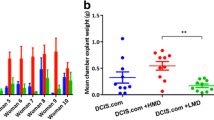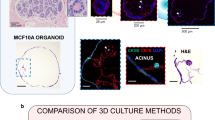Abstract
Mammographic density (MD) is the area of breast tissue that appears radiologically white on mammography. Although high MD is a strong risk factor for breast cancer, independent of BRCA1/2 mutation status, the molecular basis of high MD and its associated breast cancer risk is poorly understood. MD studies will benefit from an animal model, where hormonal, gene and drug perturbations on MD can be measured in a preclinical context. High and low MD tissues were selectively sampled by stereotactic biopsy from operative specimens of high-risk women undergoing prophylactic mastectomy. The high and low MD tissues were transferred into separate vascularised biochambers in the groins of SCID mice. Chamber material was harvested after 6 weeks for histological analyses and immunohistochemistry for cytokeratins, vimentin and a human-specific mitochondrial antigen. Within-individual analysis was performed in replicate mice, eliminating confounding by age, body mass index and process-related factors, and comparisons were made to the parental human tissue. Maintenance of differential MD post-propagation was assessed radiographically. Immunohistochemical staining confirmed the preservation of human glandular and stromal components in the murine biochambers, with maintenance of radiographic MD differential. Propagated high MD regions had higher stromal (p = 0.0002) and lower adipose (p = 0.0006) composition, reflecting the findings in the original human breast tissue, although glands appeared small and non-complex in both high and low MD groups. No significant differences were observed in glandular area (p = 0.4) or count (p = 0.4) between high and low MD biochamber tissues. Human mammary glandular and stromal tissues were viably maintained in murine biochambers, with preservation of differential radiographic density and histological features. Our study provides a murine model for future studies into the biomolecular basis of MD as a risk factor for breast cancer.








Similar content being viewed by others
References
Boyd NF, Guo H, Martin LJ, Sun L, Stone J, Fishell E, Jong RA, Hislop G, Chiarelli A, Minkin S, Yaffe MJ (2007) Mammographic density and the risk and detection of breast cancer. N Engl J Med 356(3):227–236. doi:10.1056/NEJMoa062790
Boyd NF, Rommens JM, Vogt K, Lee V, Hopper JL, Yaffe MJ, Paterson AD (2005) Mammographic breast density as an intermediate phenotype for breast cancer. Lancet Oncol 6(10):798–808. doi:10.1016/S1470-2045(05)70390-9
McCormack VA, dos Santos SI (2006) Breast density and parenchymal patterns as markers of breast cancer risk: a meta-analysis. Cancer Epidemiol Biomark Prev 15(6):1159–1169. doi:10.1158/1055-9965.EPI-06-0034
Ursin G, Ma H, Wu AH, Bernstein L, Salane M, Parisky YR, Astrahan M, Siozon CC, Pike MC (2003) Mammographic density and breast cancer in three ethnic groups. Cancer Epidemiol Biomark Prev 12(4):332–338
Byrne C, Schairer C, Wolfe J, Parekh N, Salane M, Brinton LA, Hoover R, Haile R (1995) Mammographic features and breast cancer risk: effects with time, age, and menopause status. J Natl Cancer Inst 87(21):1622–1629
Boyd NF, Byng JW, Jong RA, Fishell EK, Little LE, Miller AB, Lockwood GA, Tritchler DL, Yaffe MJ (1995) Quantitative classification of mammographic densities and breast cancer risk: results from the Canadian National Breast Screening Study. J Natl Cancer Inst 87(9):670–675
Wolfe JN, Saftlas AF, Salane M (1987) Mammographic parenchymal patterns and quantitative evaluation of mammographic densities: a case-control study. AJR Am J Roentgenol 148(6):1087–1092
Byrne C, Schairer C, Brinton LA, Wolfe J, Parekh N, Salane M, Carter C, Hoover R (2001) Effects of mammographic density and benign breast disease on breast cancer risk (United States). Cancer Causes Control 12(2):103–110
Cuzick J, Warwick J, Pinney E, Duffy SW, Cawthorn S, Howell A, Forbes JF, Warren RM (2011) Tamoxifen-induced reduction in mammographic density and breast cancer risk reduction: a nested case-control study. J Natl Cancer Inst 103(9):744–752. doi:10.1093/jnci/djr079
Boyd NF (2011) Tamoxifen, mammographic density, and breast cancer prevention. J Natl Cancer Inst 103(9):704–705. doi:10.1093/jnci/djr115
Guo YP, Martin LJ, Hanna W, Banerjee D, Miller N, Fishell E, Khokha R, Boyd NF (2001) Growth factors and stromal matrix proteins associated with mammographic densities. Cancer Epidemiol Biomark Prev 10(3):243–248
Warren R (2004) Hormones and mammographic breast density. Maturitas 49(1):67–78. doi:10.1016/j.maturitas.2004.06.013S0378-5122(04)00212-9
Lin SJ, Cawson J, Hill P, Haviv I, Jenkins M, Hopper JL, Southey MC, Campbell IG, Thompson EW (2011) Image-guided sampling reveals increased stroma and lower glandular complexity in mammographically dense breast tissue. Breast Cancer Res Treat 128(2):505–516. doi:10.1007/s10549-011-1346-0
Hariri M, Wood GA, DiGrappa MA, MacPherson M, Backman SA, Yaffe MJ, Mak TW, Boyd NF, Khokha R (2004) Experimental manipulation of radiographic density in mouse mammary gland. Breast Cancer Res 6(5):R540–R545. doi:10.1186/bcr901bcr901
Kelly JL, Findlay MW, Knight KR, Penington A, Thompson EW, Messina A, Morrison WA (2006) Contact with existing adipose tissue is inductive for adipogenesis in matrigel. Tissue Eng 12(7):2041–2047. doi:10.1089/ten.2006.12.2041
Stillaert F, Findlay M, Palmer J, Idrizi R, Cheang S, Messina A, Abberton K, Morrison W, Thompson EW (2007) Host rather than graft origin of Matrigel-induced adipose tissue in the murine tissue-engineering chamber. Tissue Eng 13(9):2291–2300. doi:10.1089/ten.2006.0382
Li T, Sun L, Miller N, Nicklee T, Woo J, Hulse-Smith L, Tsao MS, Khokha R, Martin L, Boyd N (2005) The association of measured breast tissue characteristics with mammographic density and other risk factors for breast cancer. Cancer Epidemiol Biomarkers Prev 14(2):343–349. doi:10.1158/1055-9965.EPI-04-0490
Ursin G, Hovanessian-Larsen L, Parisky YR, Pike MC, Wu AH (2005) Greatly increased occurrence of breast cancers in areas of mammographically dense tissue. Breast Cancer Res 7(5):R605–R608. doi:10.1186/bcr1260
Gill JK, Maskarinec G, Pagano I, Kolonel LN (2006) The association of mammographic density with ductal carcinoma in situ of the breast: the multiethnic cohort. Breast Cancer Res 8(3):R30. doi:10.1186/bcr1507
Provenzano PP, Inman DR, Eliceiri KW, Keely PJ (2009) Matrix density-induced mechanoregulation of breast cell phenotype, signaling and gene expression through a FAK-ERK linkage. Oncogene 28(49):4326–4343. doi:10.1038/onc.2009.299
Wang JG, Miyazu M, Xiang P, Li SN, Sokabe M, Naruse K (2005) Stretch-induced cell proliferation is mediated by FAK-MAPK pathway. Life Sci 76(24):2817–2825. doi:10.1016/j.lfs.2004.10.050
Tlsty TD, Coussens LM (2006) Tumor stroma and regulation of cancer development. Annu Rev Pathol 1:119–150. doi:10.1146/annurev.pathol.1.110304.100224
Shackleton M, Vaillant F, Simpson KJ, Stingl J, Smyth GK, Asselin-Labat ML, Wu L, Lindeman GJ, Visvader JE (2006) Generation of a functional mammary gland from a single stem cell. Nature 439(7072):84–88. doi:10.1038/nature04372
Ghosh K, Brandt KR, Reynolds C, Scott CG, Pankratz VS, Riehle DL, Lingle WL, Odogwu T, Radisky DC, Visscher DW, Ingle JN, Hartmann LC, Vachon CM (2011) Tissue composition of mammographically dense and non-dense breast tissue. Breast Cancer Res Treat. doi:10.1007/s10549-011-1727-4
Lyons TR, O’Brien J, Borges VF, Conklin MW, Keely PJ, Eliceiri KW, Marusyk A, Tan AC, Schedin P (2011) Postpartum mammary gland involution drives progression of ductal carcinoma in situ through collagen and COX-2. Nat Med 17(9):1109–1115. doi:10.1038/nm.2416
Levental KR, Yu H, Kass L, Lakins JN, Egeblad M, Erler JT, Fong SF, Csiszar K, Giaccia A, Weninger W, Yamauchi M, Gasser DL, Weaver VM (2009) Matrix crosslinking forces tumor progression by enhancing integrin signaling. Cell 139(5):891–906. doi:10.1016/j.cell.2009.10.027
McGinley JN, Thompson HJ (2011) Quantitative assessment of mammary gland density in rodents using digital image analysis. Biol Proced Online 13(1):4. doi:10.1186/1480-9222-13-4
Gierach GL, Loud JT, Chow CK, Prindiville SA, Eng-Wong J, Soballe PW, Giambartolomei C, Mai PL, Galbo CE, Nichols K, Calzone KA, Vachon C, Gail MH, Greene MH (2010) Mammographic density does not differ between unaffected BRCA1/2 mutation carriers and women at low-to-average risk of breast cancer. Breast Cancer Res Treat 123(1):245–255. doi:10.1007/s10549-010-0749-7
Mitchell G, Antoniou AC, Warren R, Peock S, Brown J, Davies R, Mattison J, Cook M, Warsi I, Evans DG, Eccles D, Douglas F, Paterson J, Hodgson S, Izatt L, Cole T, Burgess L, Eeles R, Easton DF (2006) Mammographic density and breast cancer risk in BRCA1 and BRCA2 mutation carriers. Cancer Res 66(3):1866–1872. doi:10.1158/0008-5472.CAN-05-3368
Greendale GA, Reboussin BA, Slone S, Wasilauskas C, Pike MC, Ursin G (2003) Postmenopausal hormone therapy and change in mammographic density. J Natl Cancer Inst 95(1):30–37
Rutter CM, Mandelson MT, Laya MB, Seger DJ, Taplin S (2001) Changes in breast density associated with initiation, discontinuation, and continuing use of hormone replacement therapy. JAMA 285(2):171–176
Acknowledgments
This study was supported by the Victorian Breast Cancer Research Consortium (MCS, IGC, EWT, JH), the St Vincent’s Hospital Research Endowment Fund (EWT, JC, PH 2008, 2009), and National Health and Medical Research Council (GLC, MCS, JH, IGC). SJL is supported by the NSS-PhD scholarship from the Agency for Science, Technology, and Research (A*STAR). St Vincent’s Institute and The O’Brien Institute receive infrastructure funding from the Victorian State Government under the Medical Research Operational Infrastructure program. We thank Sue MacAuley and Nadine Wood (St Vincent’s BreastScreen, St Vincent’s Hospital, Victoria) for help with radiography and tissue sampling; The Victorian Cancer Biobank (Peter MacCallum Cancer Centre) for help with tissue accrual; The Department of Pathology, St Vincent’s Hospital Melbourne, for assistance with tissue processing and immunohistochemical staining on the autostainer.
Conflict of interests
None.
Author information
Authors and Affiliations
Corresponding author
Electronic supplementary material
Below is the link to the electronic supplementary material.
Rights and permissions
About this article
Cite this article
Chew, G.L., Huang, D., Lin, S.J. et al. High and low mammographic density human breast tissues maintain histological differential in murine tissue engineering chambers. Breast Cancer Res Treat 135, 177–187 (2012). https://doi.org/10.1007/s10549-012-2128-z
Received:
Accepted:
Published:
Issue Date:
DOI: https://doi.org/10.1007/s10549-012-2128-z




